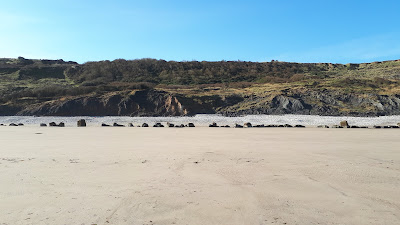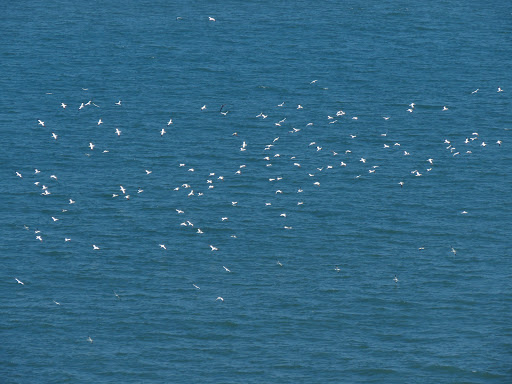
A warm, sunny day with barely any wind. I get to Reighton Sands Lane at low tide. The large expanse of sandy beach is exposed with the clear sky showing the eroding cliffs of Filey in the horizon. I descend the steep, concreted slope at Reighton Gap. Before the walk proper, I must walk towards Speeton Black Cliff, where I left it on the last stage. The massive metal boilers of the Wreck of the 'Laura' mark the walk's starting point. A woman is taking photographs of the wreck. She approaches and is very happy to explain to me the developments leading to the stranding of the steamship. A Rock Pipit sits atop some of the WW2 anti-tank blocks, nearby. Three Rooks pass overhead, first north, then south. A Stonechat feeds at the clifftop bushes.
The view from atop Reighton Sands Lane.
The wreck of The Laura
Looking towards Bempton Cliffs from Speeton Sands.
Black Cliff, Speeton.

Danish Gull
I could as well have used this ringed Black-headed Gull as a walk starting post. I first saw this individual on the last stage. This morning, it was in the same pool at low tide, within a 30-strong group of Black-headed gulls. The white plastic ring with black letters 5FY from a Danish ringing scheme is visible at long range with binoculars or from photos. I always find it exciting to find a ringed bird, especially if it is alive and in good health. It is very easy to report a ringed bird using the Euring website. I did, and quickly I got the recoveries file back from the organiser. I found out that the gull, then a three year old male, was ringed in a lake in Copenhagen, in April 2013, and since then, it has been re-sighted several times in both Speeton/Reighton Sands area and at the same place were it was initially ringed. Presumably it is breeding in Denmark, and returning in August to winter at Filey Bay.

The Ravines of Filey Bay
The cliffs of Filey Bay are made of soft, sediments forming layers of Cretaceous and Jurassic marine clays, interglacial estuarine shell beds and glacial boulder clay on top. These deposits are cut by narrow valleys or ravines, also locally called 'gills' from Old Norse, which allow access to the beach (the 'gaps'). In contrast with the often bare lower cliff faces and the developed or arable cliff tops, the ravines are wildernesses, with scrub and trees, providing shelter and food for migrant birds. Today, the hawthorns and brambles had plenty of berries, and on the south facing slopes, insects swarmed around the bushes. In addition to the constant attrition by the sea, the clay cliffs of Filey Bay suffer from landslides or slumping as clay liquefies when wet, which can be seen as areas of less vegetation intruding onto the beach. Beware this clay can be very soft after rains or storms and become a shoe trap!
Slipway by The Gill.
The stage today started near Old Beck, near Speeton, where there is a right of way to the beach. Shortly after I pass by The Gill, where a slipway allows access from Reighton Caravan Park). People from the caravan park congregate around the slipway. Dogs chasing balls, children make sandcastles, walkers and horse riders make use of the beach. It is such a wide beach that it is easy to maintain social distance.
A Kestrel hovers near Hunmanby Gap. Here, another small ravine with a beck reaching the beach. Pillboxes on the beach. I find a dead adult gannet on the tideline with no head or legs.
The walking is easy on the beach by the cliff, as the tideline is right at the bottom of the cliff and the sand compacted by the previous high tide. I reach another small ravine, Butcher Havem, it's beck, Flat Cliff Gill, freely flowing onto the sand. This one doesn't seem to have access, vegetation clogging it quickly near the beach. On the way back later, a Grey Wagtail has found it good for a stop during migration.
Flat Cliff Gill.
Grey Wagtail.
Another short stretch and I get to Primrose Valley. This is a much larger, wooded ravine. The beck has to be crossed with a bridge. Steps allow access to the clifftop and I take the chance for a change of scenery. The steep path cuts across the wood and scrub, and the clifftop by a golf course, is fringed by scrub and rough grass. Two Stonechat feed from the bushes. Normally Stonechat feed on the ground from a perch, but there are so many insects about that they are feeding flycatcher style. A flock of Lon-tailed Tits is feeding on a sycamore that is buzzing with insect in the midday sun.

An ammonite sculpture by Martin's Gill.
Reed Bunting.
I do the same route in the way back, but I take the clifftop path between Hunmanby Gap and Reighton Sands. This offers fantastic views towards Bempton Cliffs.
Bird Observatories
Filey Bird Observatory and Group recording area starts on Speeton, with a sharp boundary between the Flamborough Bird Observatory recording area and the FBOG recording area, this shows how fantastic is this bay for migratory birds! Hunmanby Gap is a well watched visible migration site and ringing station part of the bird observatory, this is its Trekkelen site.
Featured Bird: Stonechat
Stonechats are small passerines that like to sit in prominent perches. They are common during the autumn migration, peaking in mid October, and they also winter in the Yorkshire coast. In Filey Bay they are also a breeding bird. The scrubby cliffs suits them very well. Stonechats are not considered of conservation concern, although population declines have been noted after hard winters.
Walk information
12 km circular. Start on Reighton Gap car park, TA139762. Finish at Martin's Ravine, Filey. Public toilets at Primrose Valley, Filey Promenade. Beach access at Speeton, Reighton Gap, Hunmanby Gap and Primrose Valley. Check tides. section from Reighton Gap to Hunmanby Gap and from Primrose Valley to Filey can be walked on clifftop path.
More information









































